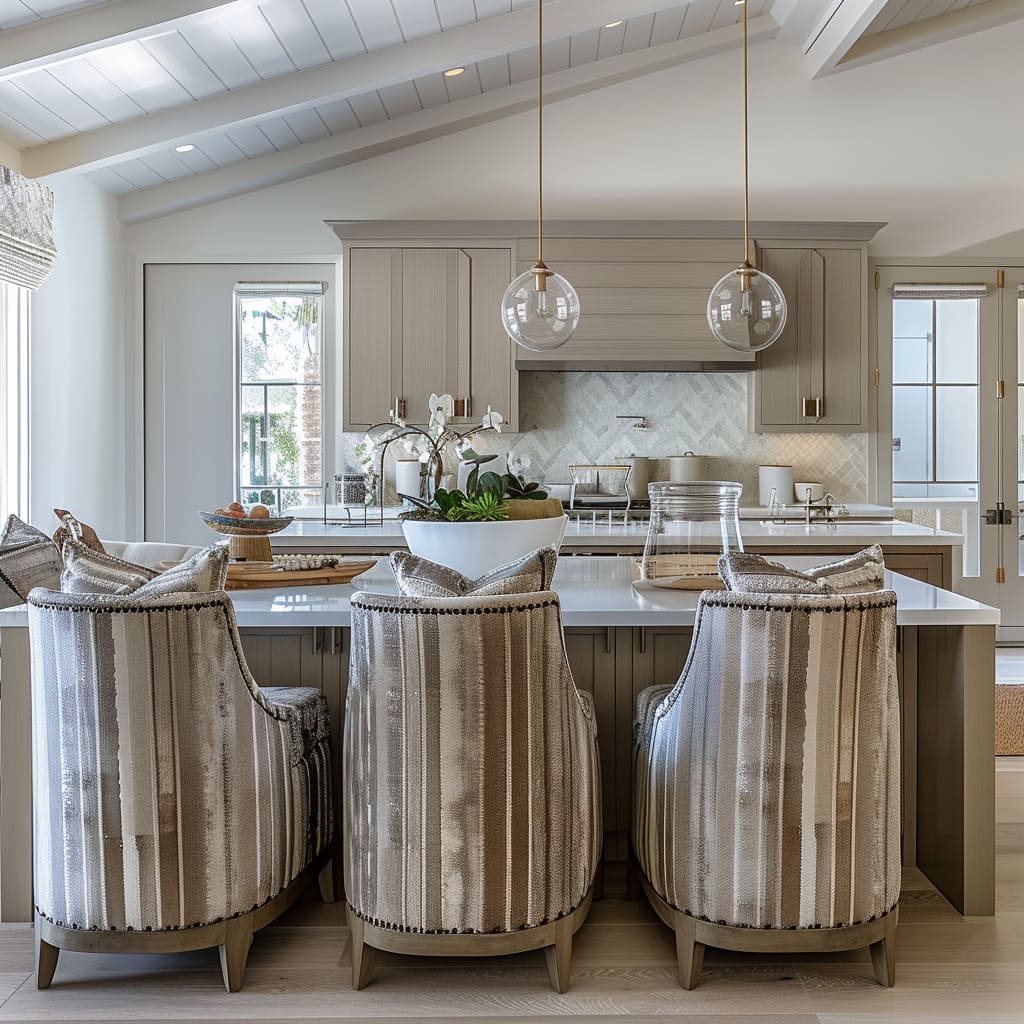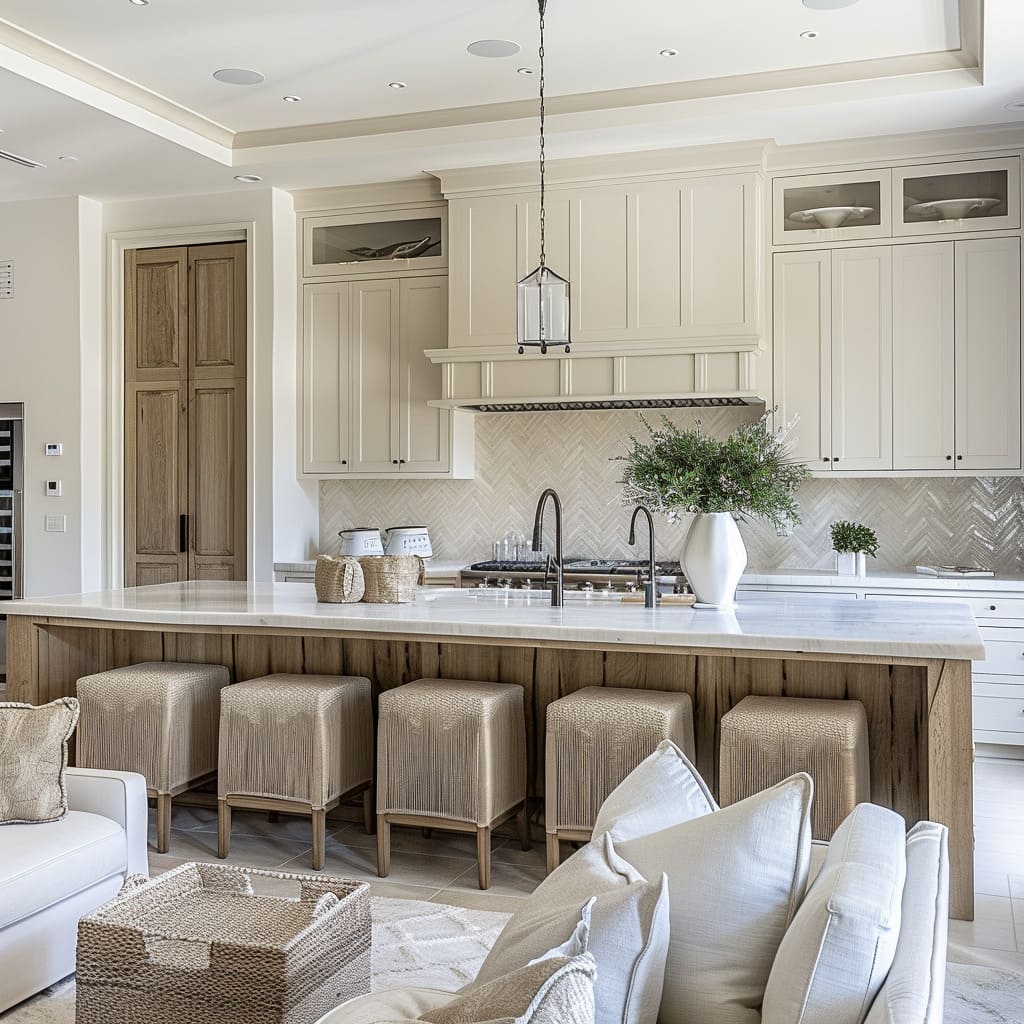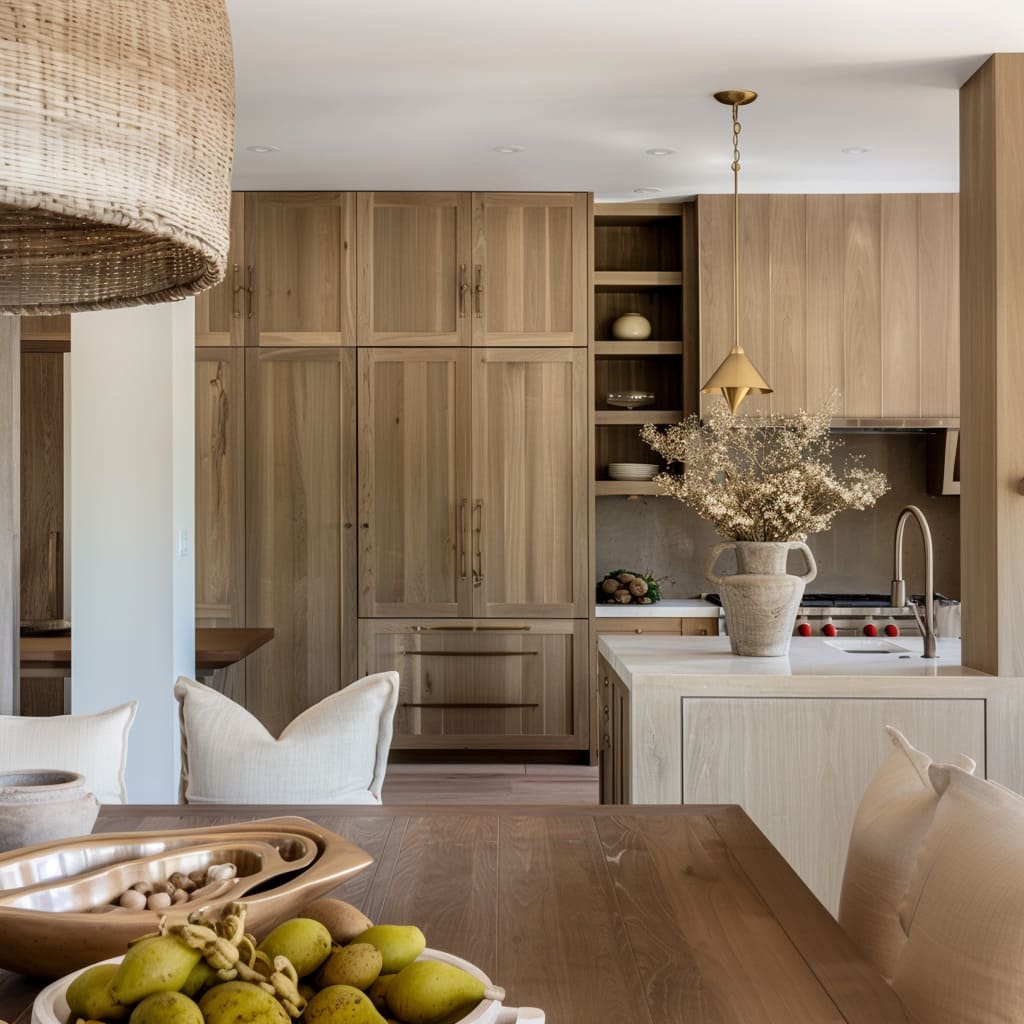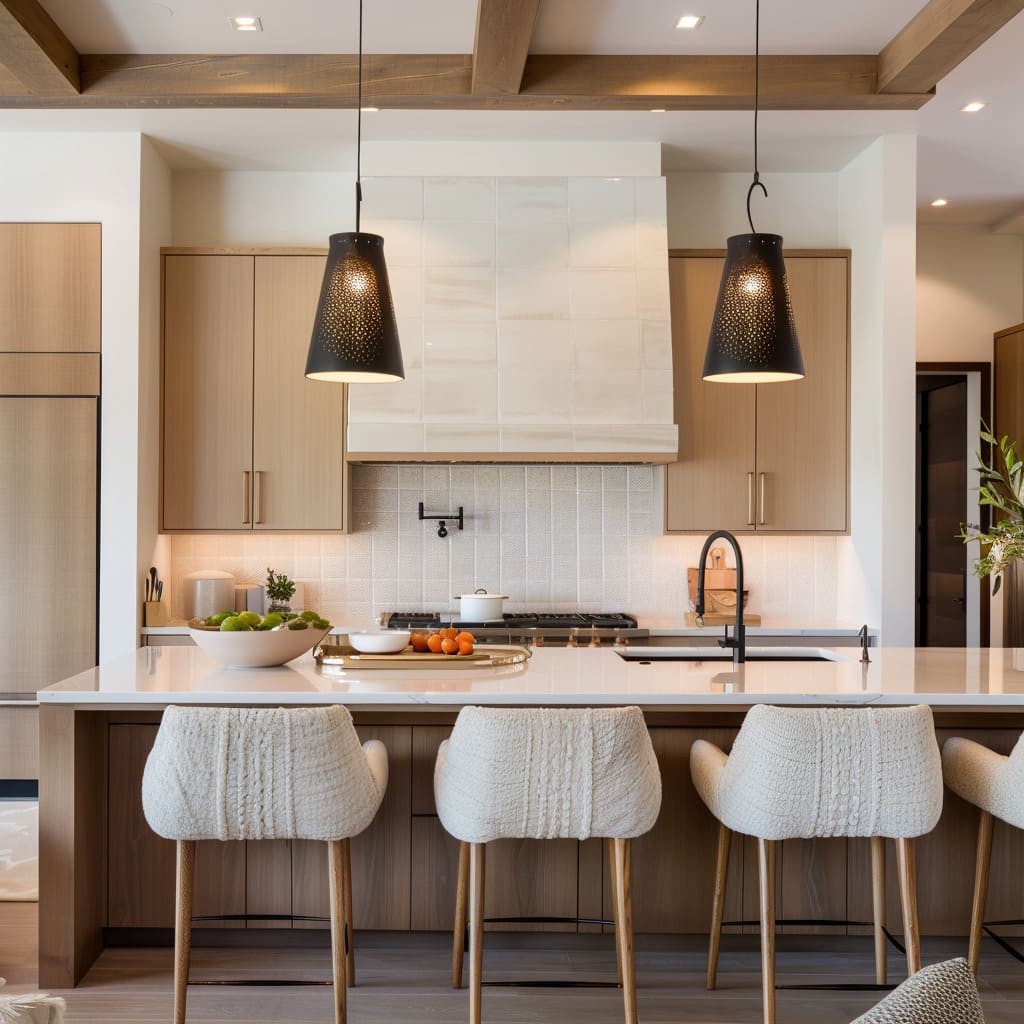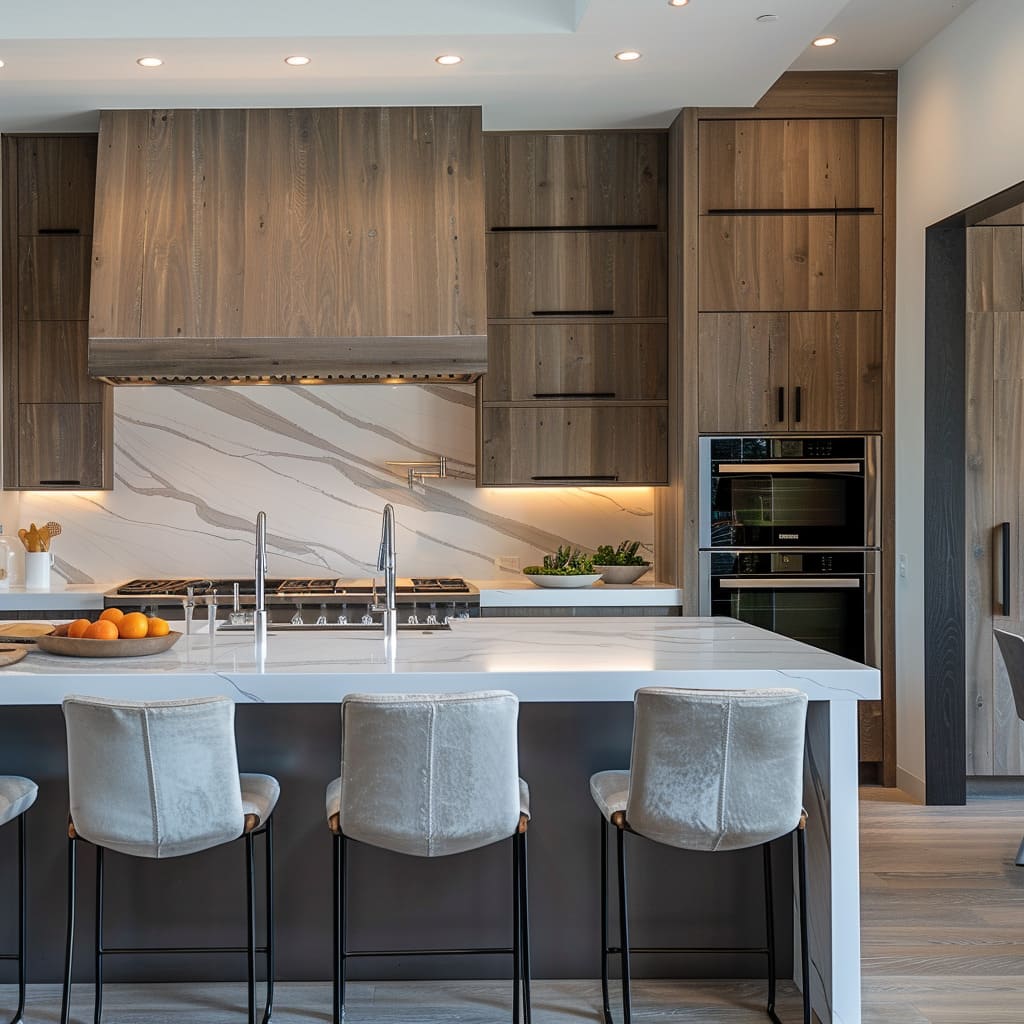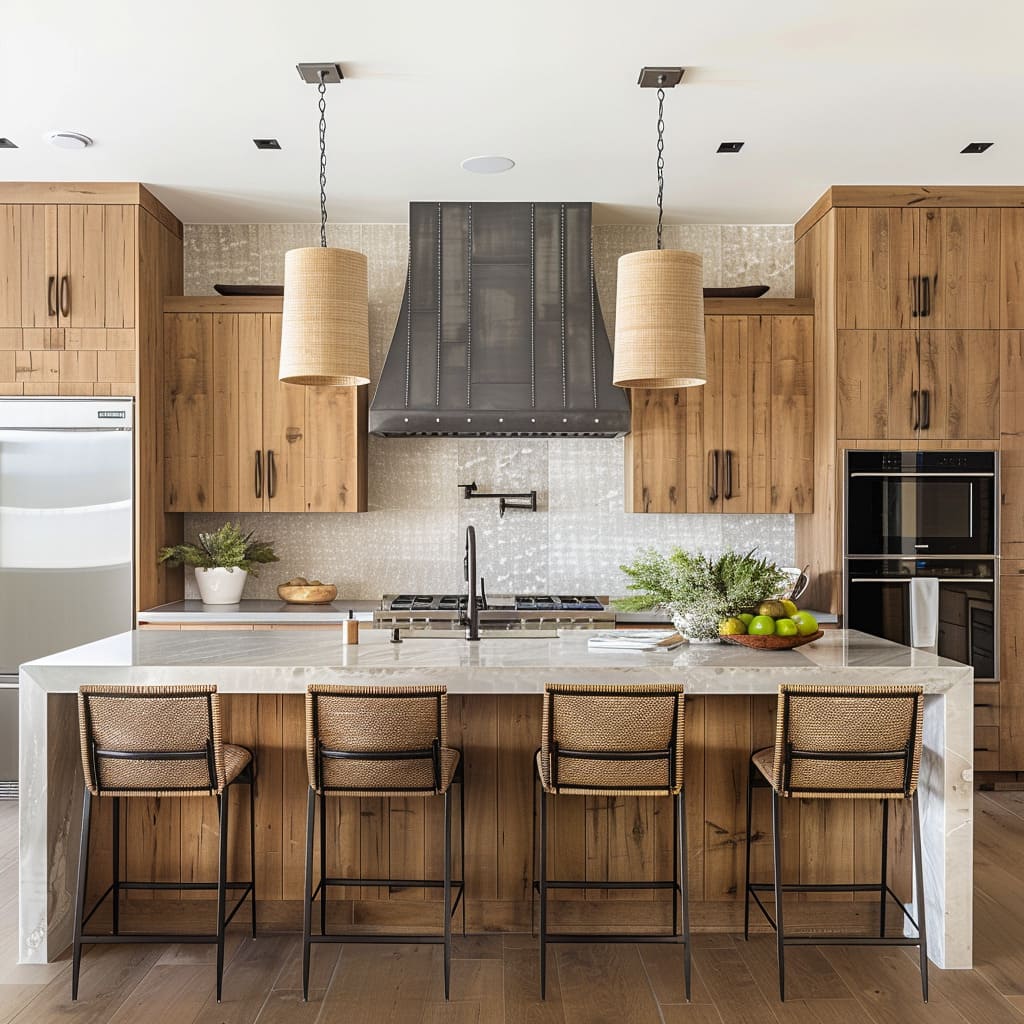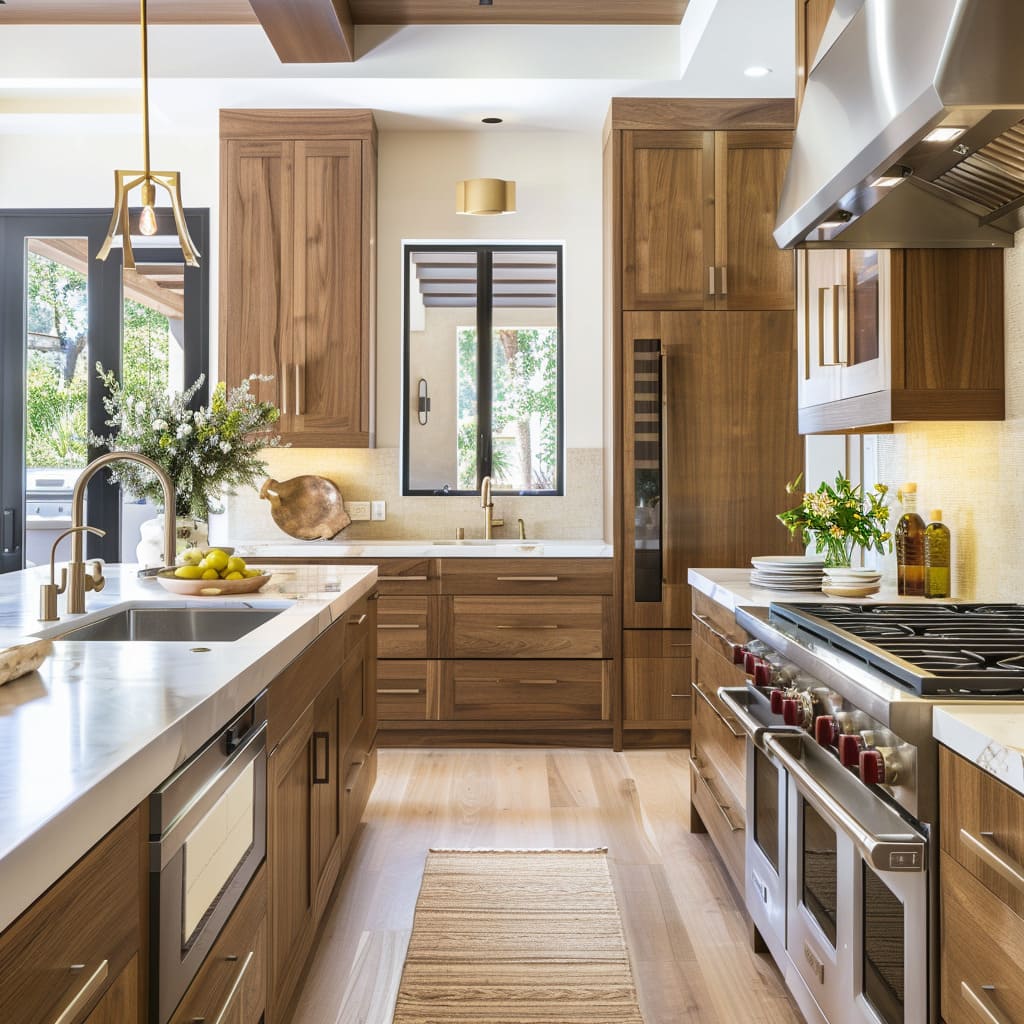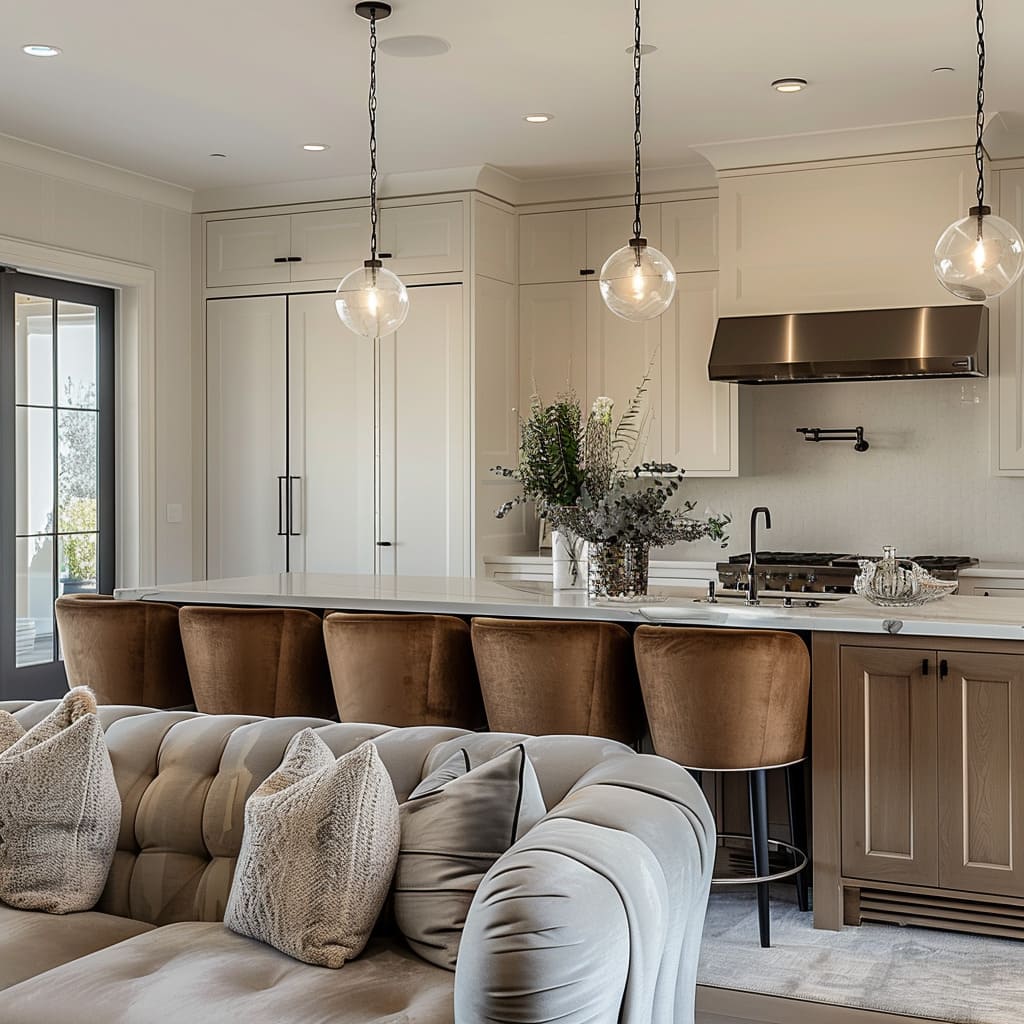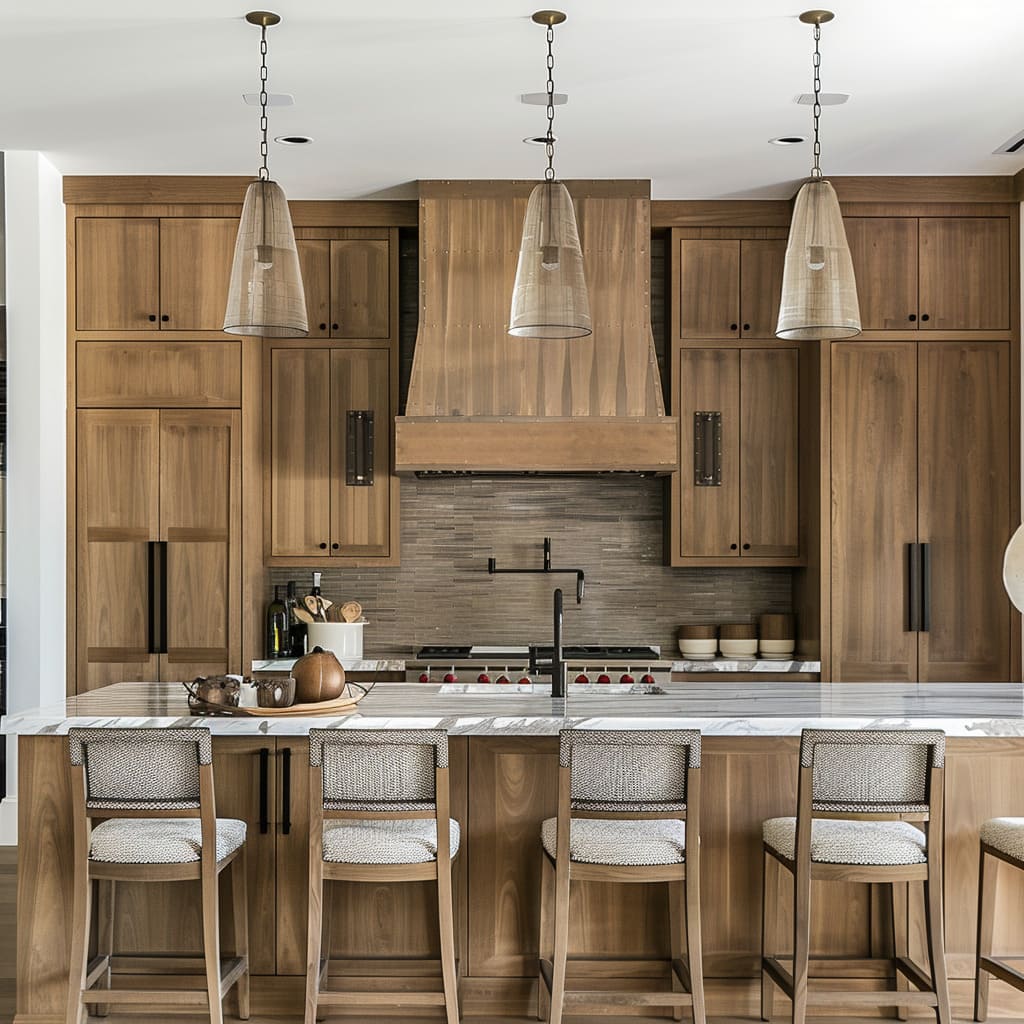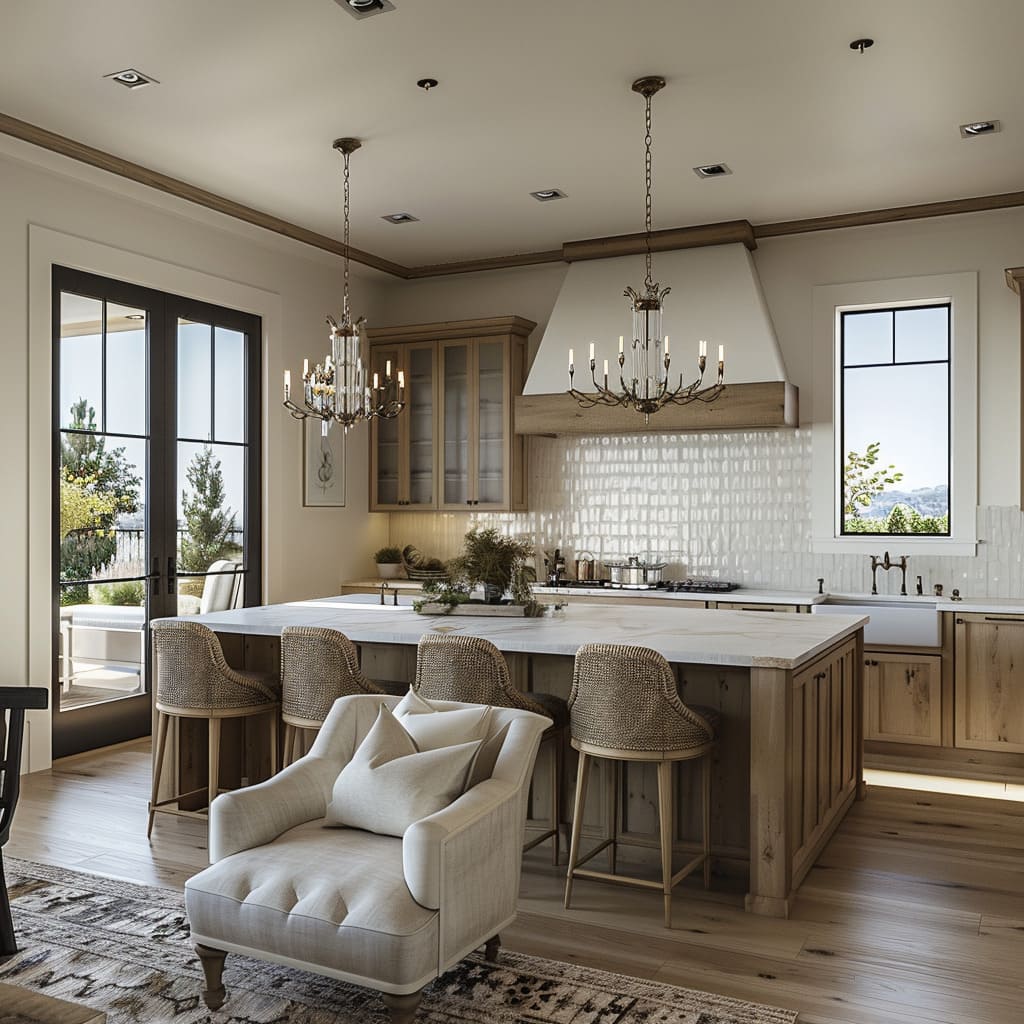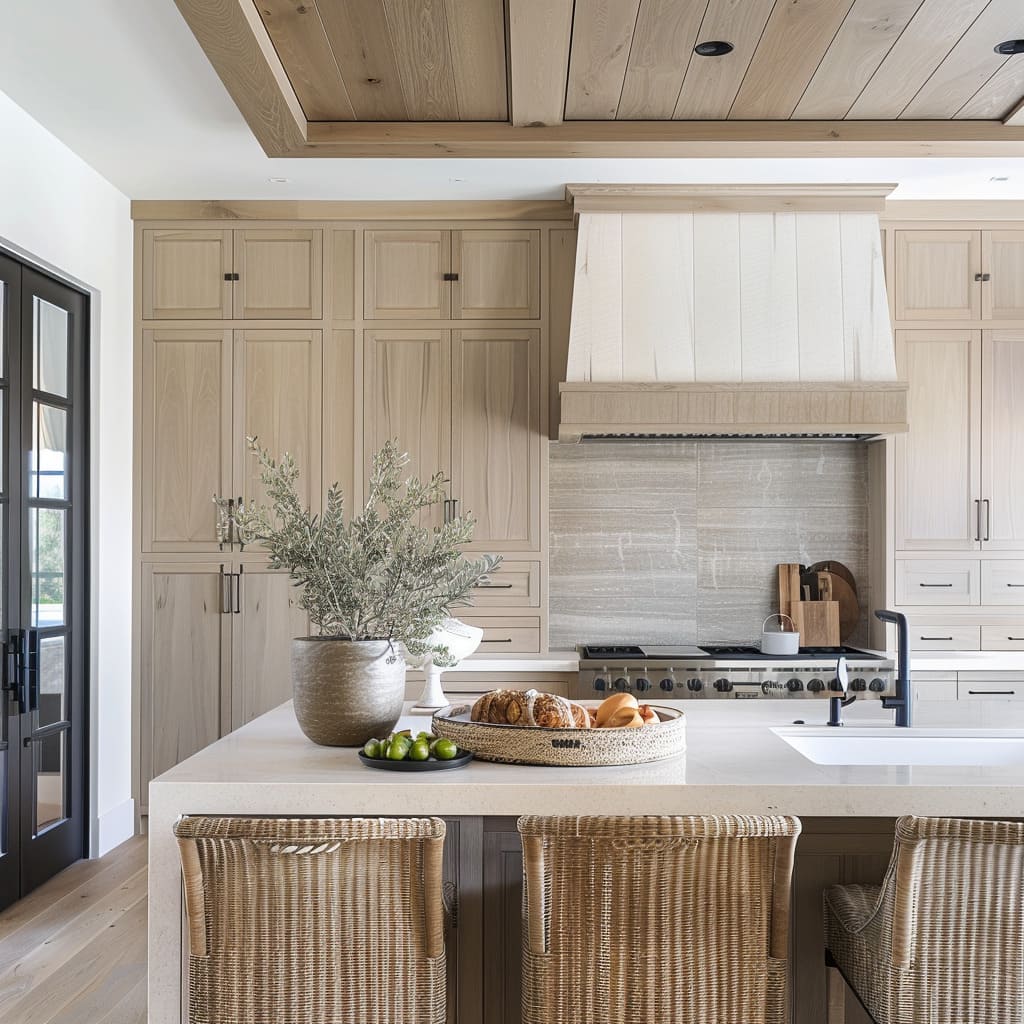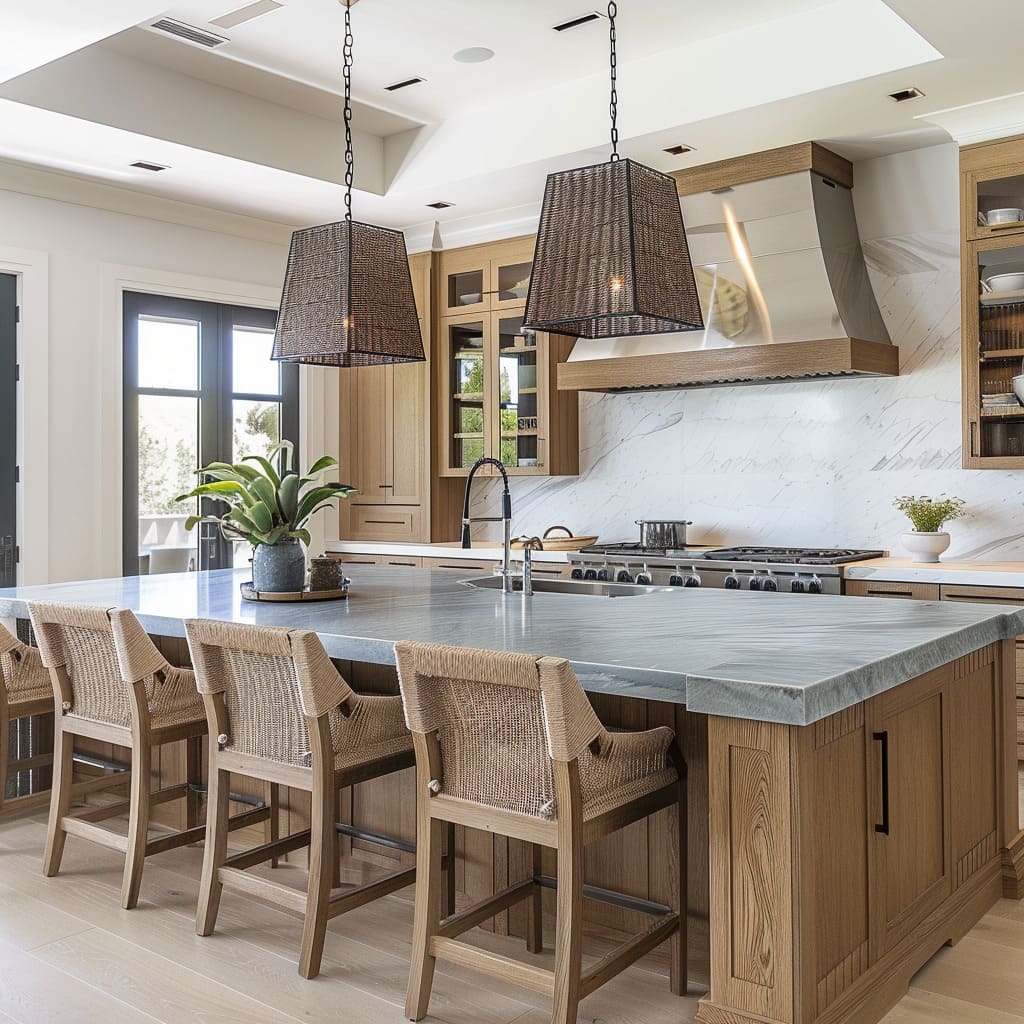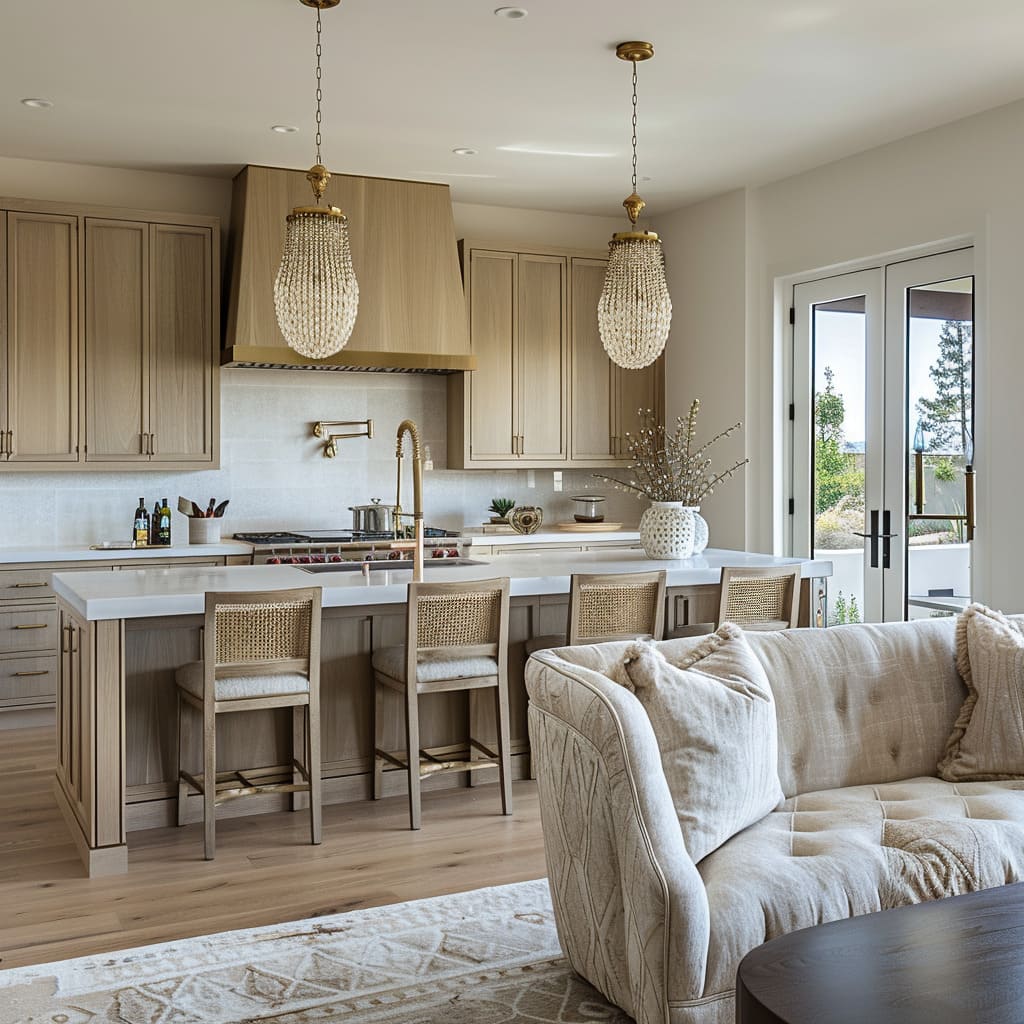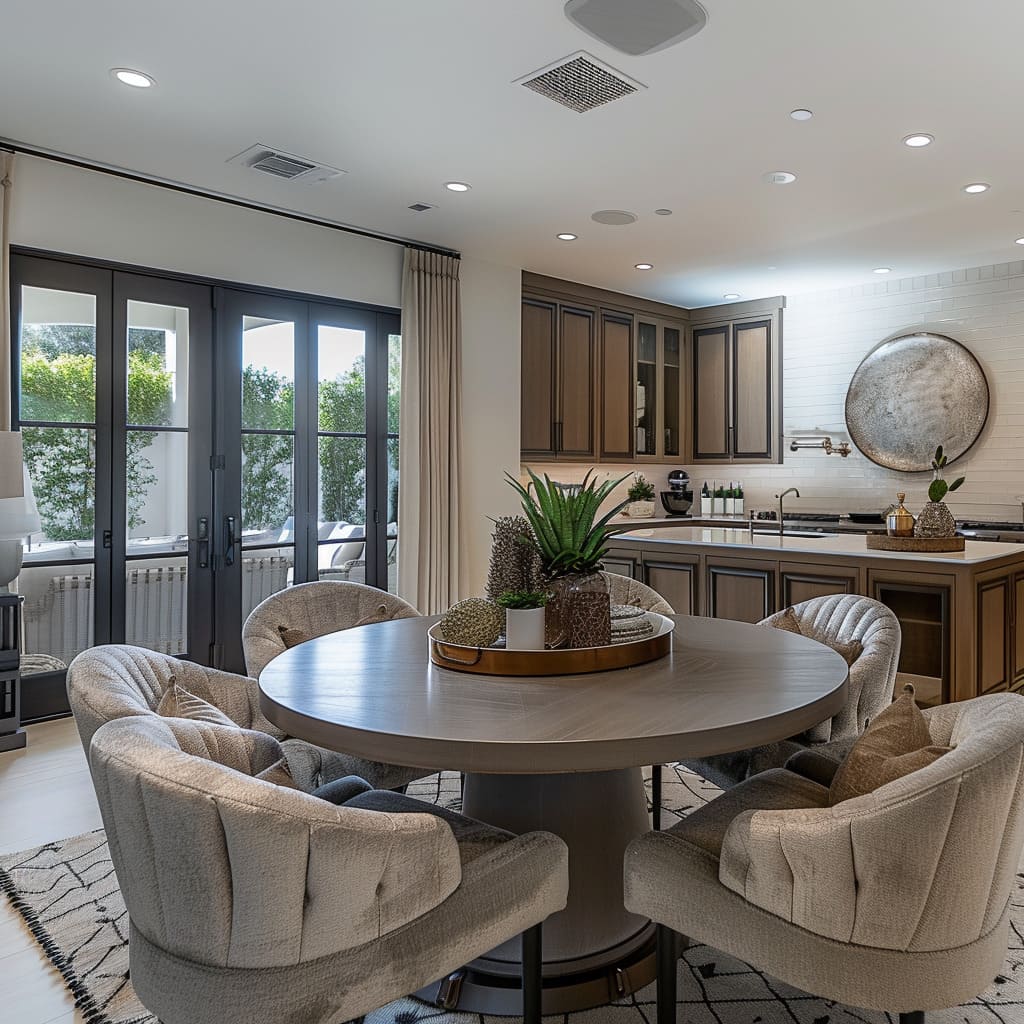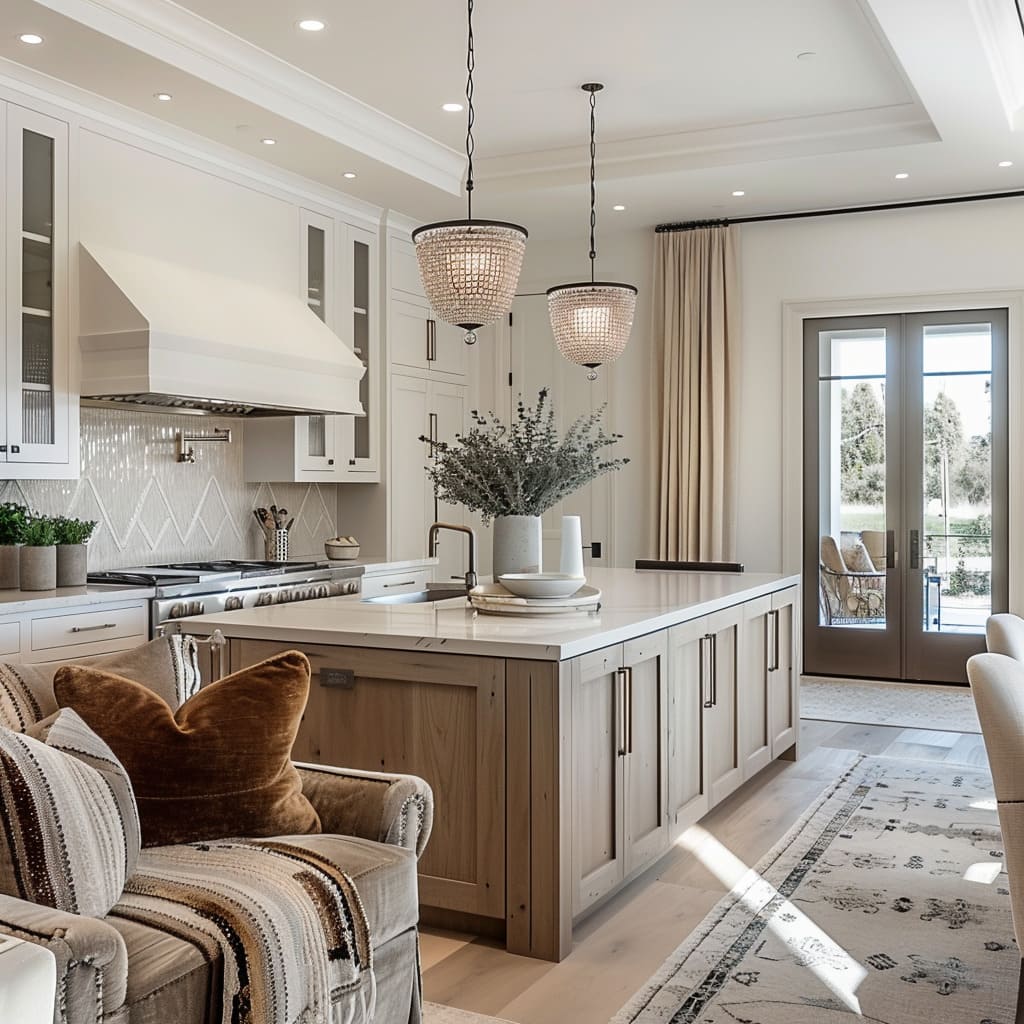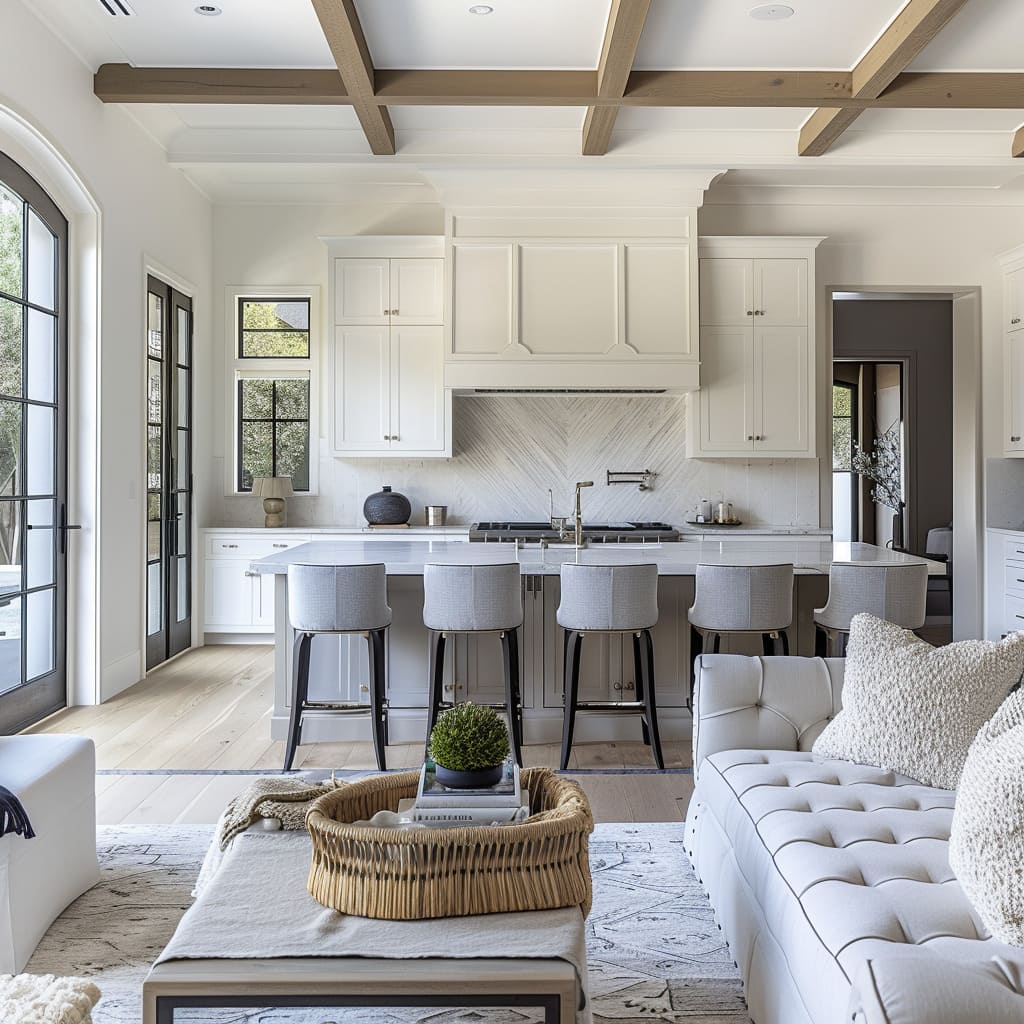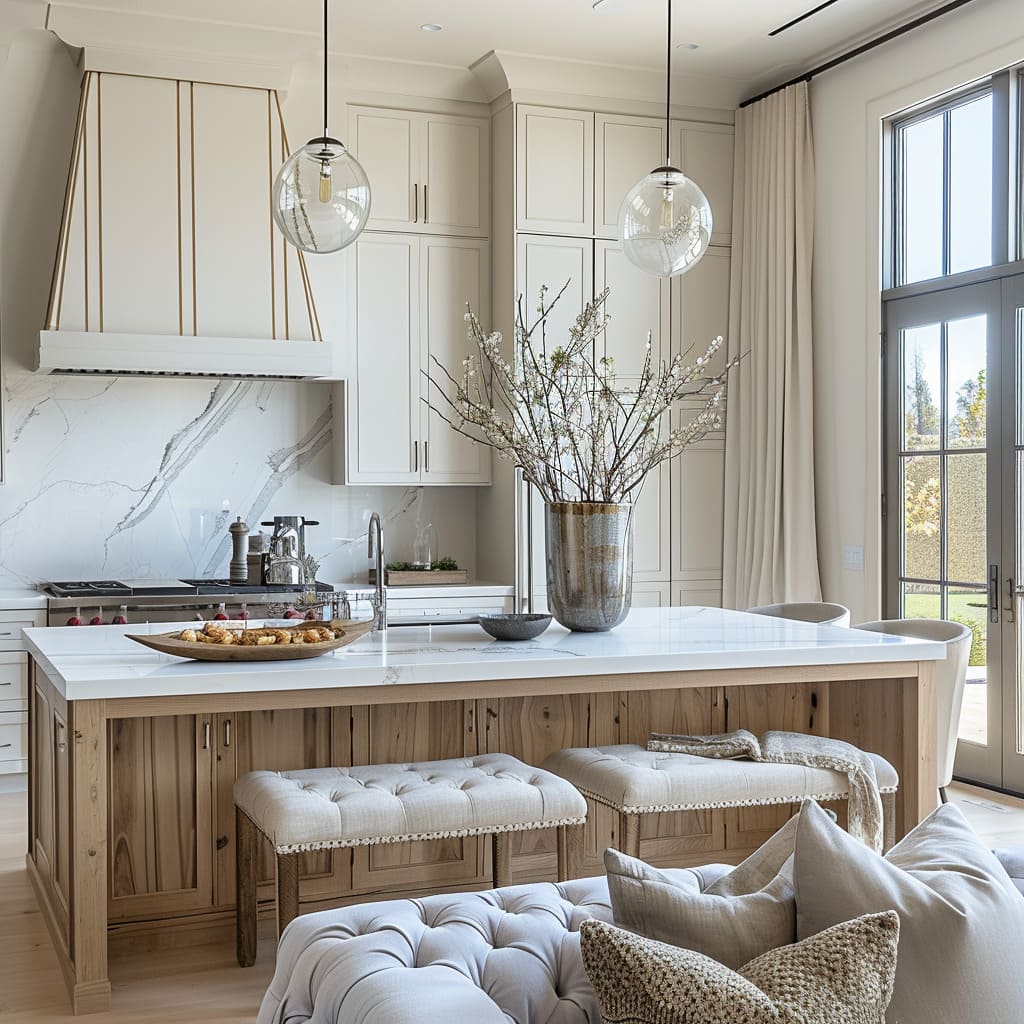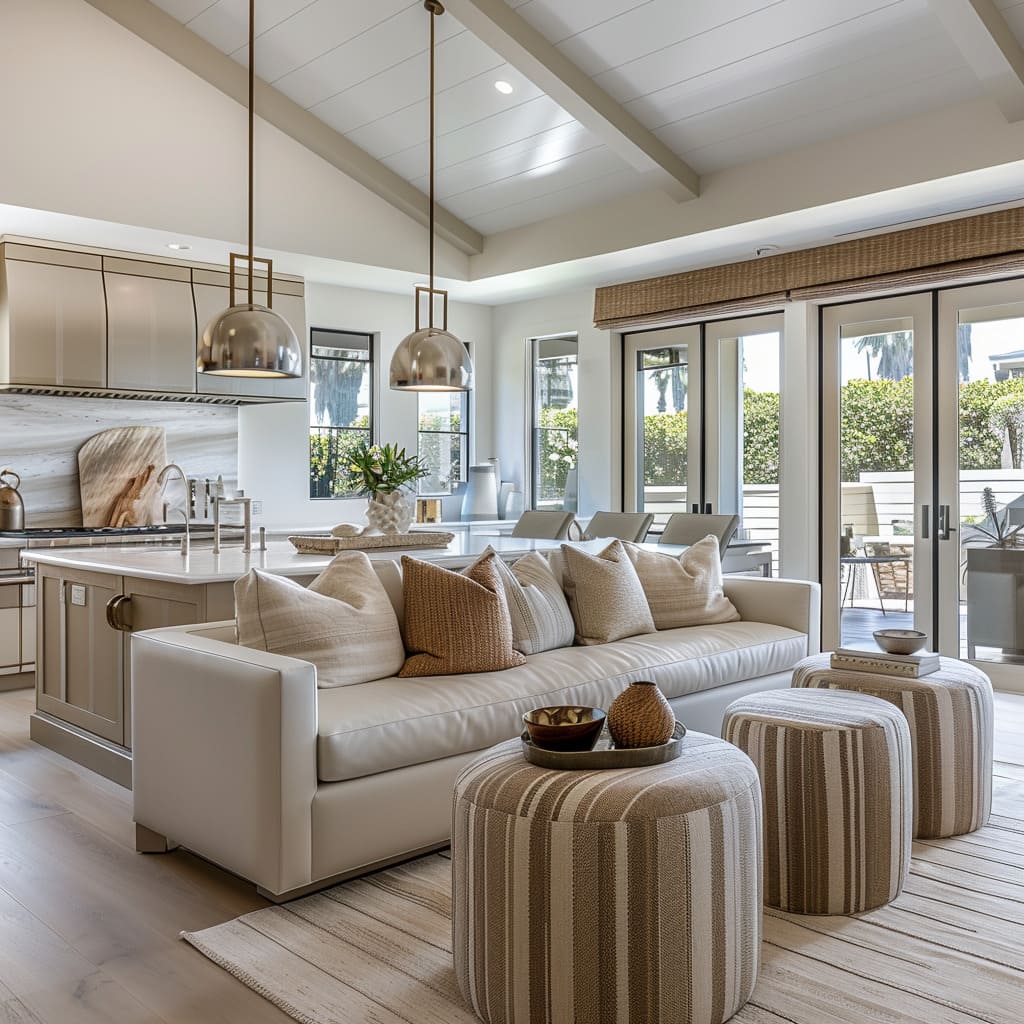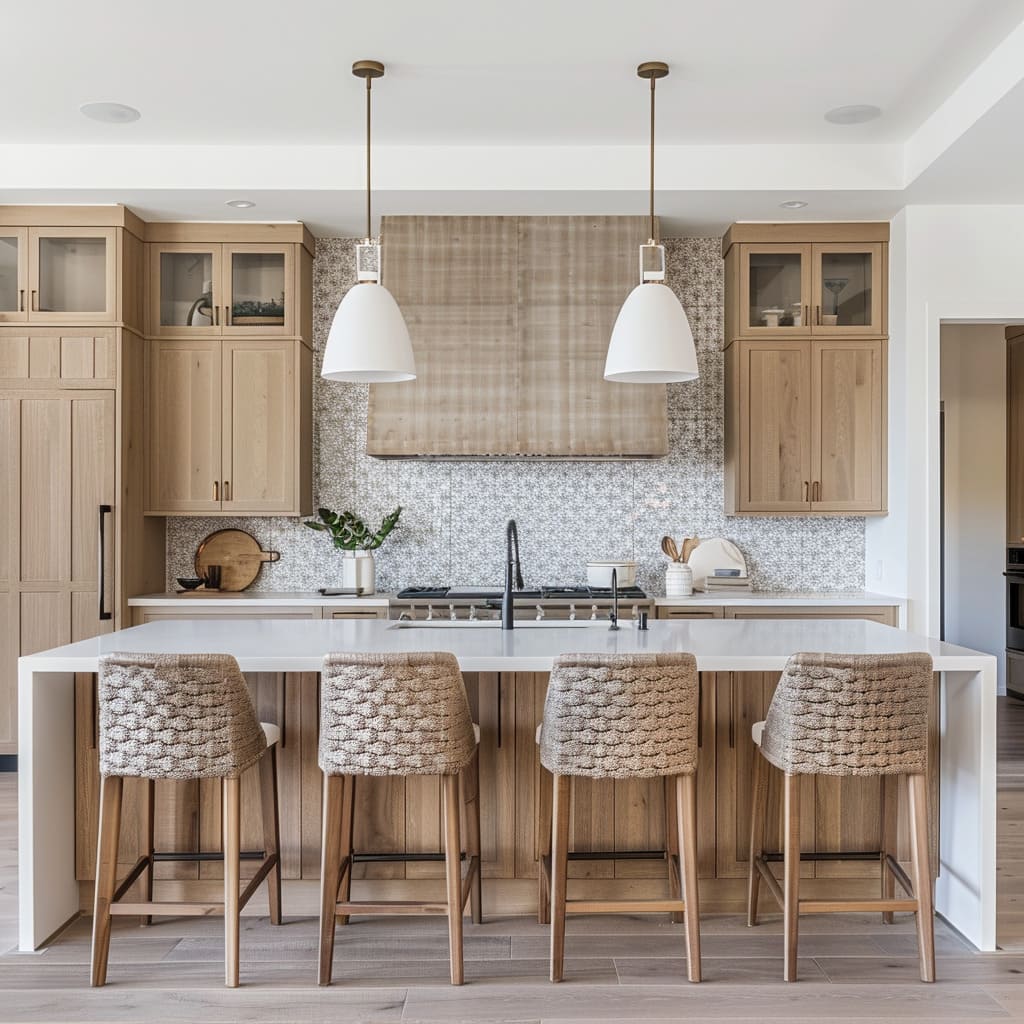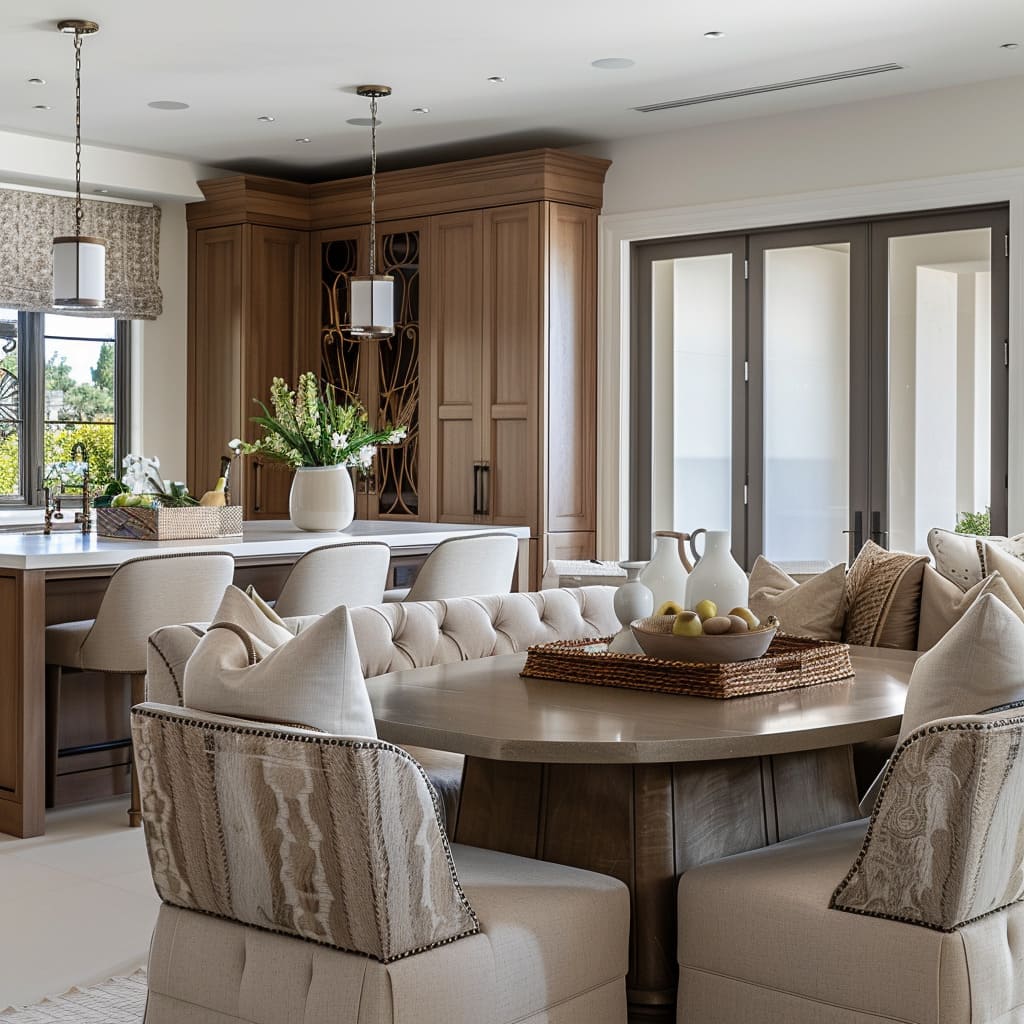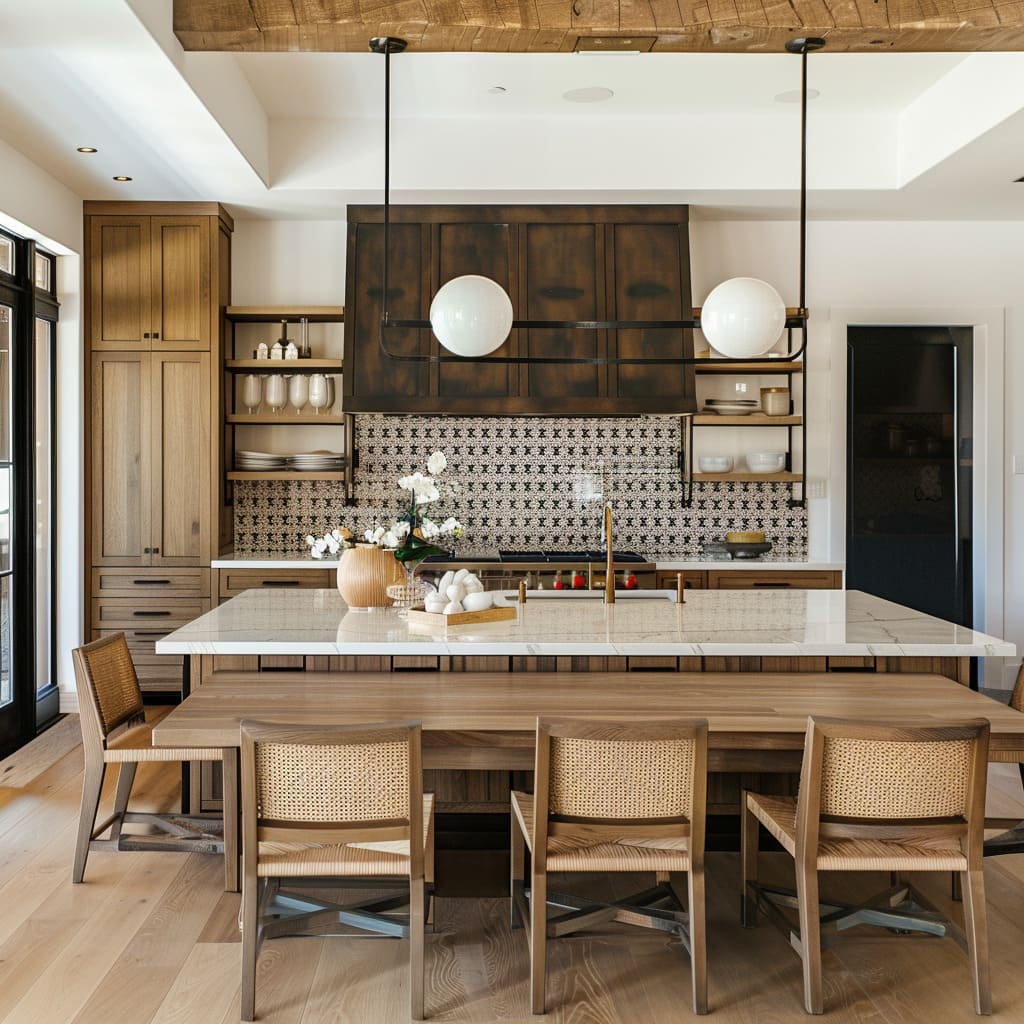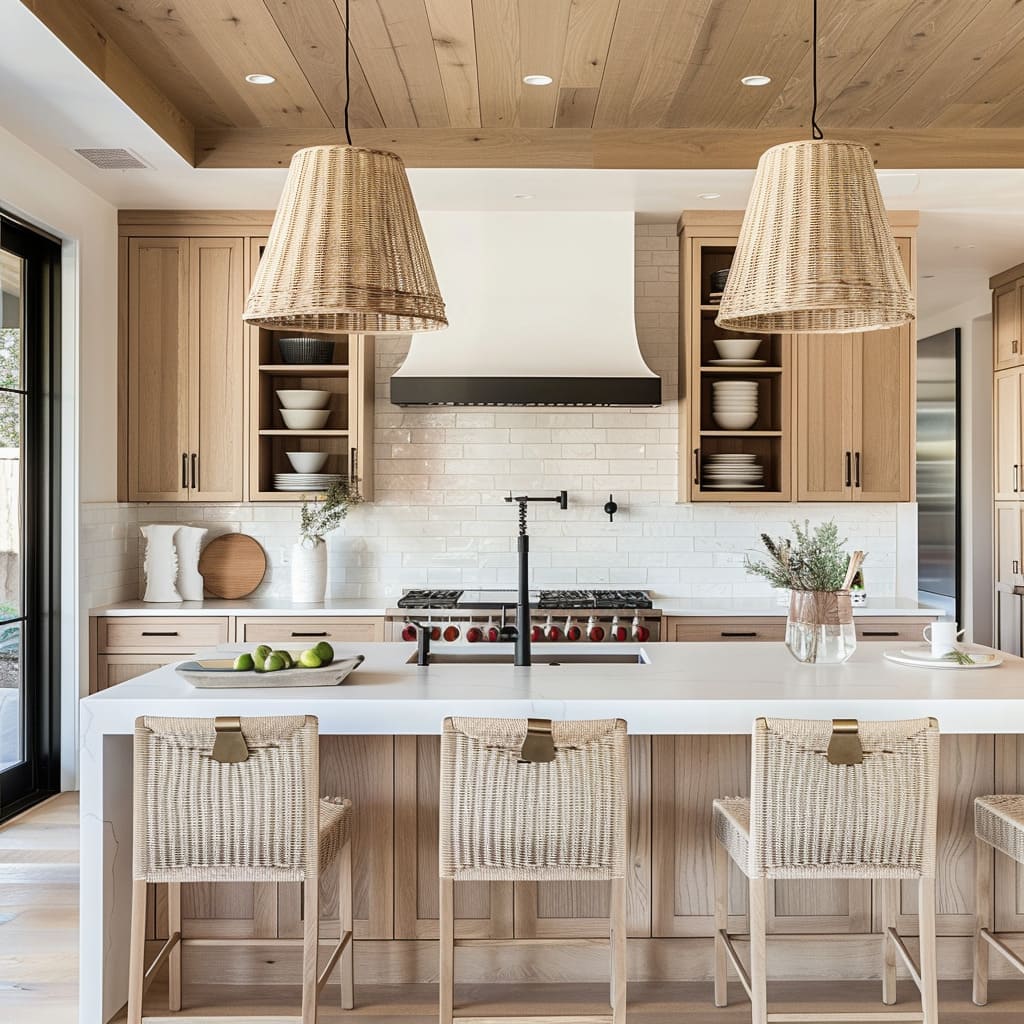In the heart of the home, the kitchen stands as a testament to the delicate dance between tradition and innovation, a space where the warmth of the past meets the streamlined functionality of the present. This article unfolds the layers of a kitchen design that marries the rustic allure of farmhouse aesthetics with the crisp, clean lines of modernity.
It’s an exploration of spaces that are not just for culinary pursuits but for life itself — where every cabinet, every tile, and every beam tells a story of gathering, creating, and living. Through a lens focused on the tangible elements that define these spaces, we discover how wood’s natural warmth, the precision of modern fixtures, the ingenuity of integrated storage, and the communal joy of gathering spots weave together to form a kitchen that’s both a sanctuary and a hive of activity.
Timeless Foundations
At the heart of these kitchens lies a reverence for enduring materials and designs that ground the space with a sense of permanence and tradition. The Wood as a Central Material and Exposed Beams are pivotal in establishing this timeless quality, offering warmth and a nod to rustic origins.
Marble Countertops elevate the space with their classic veining, while Apron Sinks bring in the quintessential farmhouse feel. These elements are the building blocks that give the kitchen its soul.
Wood as a Central Material
The use of wood, from the palest ash to deep walnut, offers an array of natural hues that coalesce to create a welcoming atmosphere. Cabinets and floors display wood’s natural grain, celebrating its organic beauty and bringing an essence of nature into the home.
Each plank and panel tells its own story, creating a rich backdrop for modern living. Discover the benefits and sleek appearance of using a tempered glass backsplash behind stove in contemporary kitchen designs.
Exposed Beams
The ceilings showcase wooden beams that traverse the overhead space, offering a visual connection to the storied barns and pastoral dwellings of yesteryear. These beams are not mere relics but are interwoven into the design as pivotal elements that celebrate structural integrity and aesthetic warmth.
Marble Countertops
The cool touch of marble counters provides a smooth, durable surface for meal preparation. Its veining is akin to delicate brushwork on a pristine canvas, introducing a subtle, artistic vibe.
The use of marble also signifies an affinity for enduring quality and a penchant for timeless appeal.
Apron Sinks
Deep and wide, the apron front sinks in these kitchens echo a design that has been a centerpiece in homes for generations.
They are practical for handling large dishes and bountiful harvests from the garden, marrying functionality with a visual echo of age-old kitchen traditions.
These elements, in concert, create a solid foundation that resonates with both past and present, embodying a design ethos that is as enduring as it is visually warm and welcoming. For a deeper exploration into the evolving aesthetics and practicality of culinary spaces, check out this insightful article on the art and science of modern kitchen design.
Functional Artistry
Kitchens are workshops of creativity, and the tools and fixtures within them serve both utilitarian and aesthetic purposes. Contrasting Black Accents and Simple Cabinet Hardware provide not just functionality but also an element of visual interest.
If you are looking for luxury kitchen design ideas, explore the pinnacle of sophisticated living in our comprehensive guide on luxury kitchen interior design. Utilitarian Faucets and Integrated Sinks merge efficiency with sleek design, making everyday tasks more pleasurable.
Pendant Lighting and Under-cabinet Lighting are not just light sources; they are curated to enhance the ambiance and functionality of the cooking area.
Contrasting Black Accents
The dark tones of the hardware punctuate the lighter surroundings with a contemporary flair, offering a striking visual balance. The sleek drawer pulls and cabinet handles stand out against the cabinetry, their matte finishes absorbing the light to create depth and dimension in the space.
Simple Cabinet Hardware
The minimalist design of the hardware allows for ease of use and maintains a clean visual flow. Each piece, while unobtrusive, is chosen with consideration, ensuring the cabinets present an unbroken and refined façade that complements the surrounding textures and materials.
For a detailed look at integrating classic and contemporary elements through cabinetry, visit our feature on transitional style kitchen cabinets.
Utilitarian Faucets
Faucets rise with purpose, their statuesque forms and functional elegance suggesting efficiency and grace.
They are designed to handle the day-to-day activities with ease, their sprouts and handles offering a tactile experience where form faithfully follows function.
Integrated Sinks
The integration of sinks into the countertops offers a smooth transition from surface to basin, ensuring that the line of sight is undisturbed by protrusions or gaps. This integration helps maintain a simplicity that is both modern and timeless, allowing the quality of materials to stand at the forefront.
Pendant Lighting
An assortment of pendant lights hangs like suspended sculptures, their designs varying from slender cones to expansive domes. They cast focused light on the surfaces below, creating islands of illumination that highlight the textures and contours of the counters and workspaces.
Under-cabinet Lighting
Soft luminescence emanates from beneath the cabinets, offering a glow that accentuates the backsplash while providing practical lighting for food preparation. This feature showcases the intricate designs of the tiles and brings a depth to the space that the overhead lights cannot achieve alone.
Storage and Organization
A seamless integration of storage solutions ensures that these kitchens remain clutter-free and organized. Shaker-style Cabinetry offers a timeless look that hides modern organizational systems within.
Hidden Appliances and Frosted Glass Cabinet Inserts contribute to the clean lines of the kitchen, while Open Shelving invites a more laid-back, accessible feel. Hanging Pot Racks display cookware within easy reach, marrying form and function.
Shaker-style Cabinetry
The cabinetry, distinguished by the recessed panels, speaks to a preference for understated design that stands the test of time. The uniformity of the shaker panels creates a rhythm across the kitchen walls, bringing a visual calm that soothes the space.
The craftsmanship is evident in the precise lines and the smooth operation of doors and drawers, showcasing the fusion of aesthetic appeal and practical design.
Hidden Appliances
In these culinary retreats, appliances blend into the environment, concealed within cabinetry that mirrors the room’s design language.
This seamless integration ensures the visual flow is uninterrupted by technological intrusions, allowing the beauty of the design to take center stage. It’s a thoughtful approach that highlights the kitchen’s dual role as a place for both vigorous culinary activity and tranquil togetherness.
Frosted Glass Cabinet Inserts
The cabinets with frosted glass inserts bring a hint of translucence to the space, softening the solidity of the wood with a gentle diffusion of light. This choice adds a layer of texture and depth, offering glimpses of the cabinet’s contents without the need for full disclosure.
It’s a design choice that marries privacy with the invitation to explore, creating an interplay between the seen and the unseen.
Open Shelving
Open shelving offers a stage for items that are both useful and beautiful, promoting an atmosphere where accessibility is harmonious with display.
These shelves encourage a curated presentation of kitchenware, turning everyday objects into exhibits of personal style. The absence of doors invites interaction and celebrates the idea of openness, both in design and in the act of sharing the kitchen’s offerings.
Hanging Pot Racks
Where space allows, pot racks dangle from the ceiling, their presence a functional statement that harkens back to kitchens centered around hearty feasts and home cooking. The pots and pans, each with their own patina of use, hang within arm’s reach, ready to be enlisted in the creation of the next meal.
More than just a storage solution, these racks are a celebration of the joy of cooking, the pans and pots displayed proudly like medals of culinary endeavors.
Central Gatherings
The kitchen island stands as a communal hub in these designs, where beauty meets practicality. The Island as a Focal Point is not just a design choice; it’s a central stage for interaction, prep work, and casual dining.
Complementing this are the Substantial Wood Tables that often double as gathering spaces for meals and activities, emphasizing the kitchen’s role as a convivial space.
Island as a Focal Point
The island stands as more than just a part of the kitchen; it’s a versatile cornerstone that supports a dynamic flow of activities.
Positioned with intention, it anchors the space, providing a generous surface for meal preparation while simultaneously serving as a communal spot for casual meals or a cup of coffee shared between friends. The choice of material, often complementing the countertops, adds to its centrality, reflecting the light and activity of the bustling space around it.
Substantial Wood Tables
In some instances, the island gives way to a substantial table, offering an alternative gathering place. These tables, constructed from solid wood, carry a gravitas and a palpable sense of stability.
They offer not just a surface for dining but a shared area for life’s unfoldings — from homework sessions to heart-to-heart conversations. The tables stand on robust legs that speak to both their craftsmanship and their role as a foundational piece in the tapestry of home life.
These central elements in the kitchen perform a dual function, serving both practical needs and social interactions. They are deliberately placed to draw in family members and guests, encouraging connection and engagement in a world where such moments are increasingly cherished.
They are not just furniture; they are platforms for life’s many, varied experiences, crafted to support the weight of these moments — both literal and figurative.
Varied Seating Dynamics
The way seating is approached in these kitchens reflects a desire for variety and versatility. Mix of Chair Styles around the island introduces an eclectic vibe, while Bar Stools offer a more casual perch for quick meals or socializing.
Together, they reflect a layered approach to seating that caters to different occasions and interactions.
Mix of Chair Styles
A thoughtful selection of chairs encircles the island, each with its own unique profile, yet all harmoniously unified in their purpose.
This variety reflects an understanding that each person may have a different preference for comfort, and it allows for the space to adapt to various occasions, whether it’s a quick breakfast or an extended evening of socializing. The chairs themselves, ranging from cushioned seats to more rigid, sculptural forms, contribute to the room’s visual and tactile diversity.
Bar Stools
The bar stools, often found by the kitchen island, embody a simplicity that enhances the spaciousness of the area. Their sleek lines and absence of backrests ensure that nothing obstructs the view across the kitchen or into adjoining spaces.
These stools are as much a statement in minimalism as they are a functional component of the kitchen, facilitating flow and conversation without the bulk of traditional seating. They tuck away neatly when not in use, their profiles as understated as they are elegant.
Together, these varied seating options underscore a flexibility inherent in the kitchen’s design, acknowledging that each individual’s presence is as vital to the space as the ingredients in the pantry. The seating encourages pauses in the day for connection and conversation, serving not only as functional spaces but as silent catalysts for interaction and engagement.
Decorative Details
It’s the subtle touches that add character and uniqueness to a space. Backsplash Tiles and Accent Tiles introduce texture and pattern without overwhelming the senses.
Range Hoods are chosen for their ability to command attention, often serving as the kitchen’s statement piece. These details are like the final brush strokes on a canvas, completing the picture.
Backsplash Tiles
The backsplash serves as a canvas for expression, with tiles that boast artisanal craftsmanship. Each tile, though similar to its neighbors, varies slightly in shade or texture, contributing to a dynamic tableau that catches the eye.
This detail adds a tactile dimension to the space, inviting touch and closer inspection, and the subtle differences in the tiles echo the individuality found in nature.
Accent Tiles
The inclusion of accent tiles provides a punctuation of distinction within the larger design scheme.
Whether they form a border or an inset pattern, these tiles are a thoughtful touch that elevates the kitchen from a purely functional space to one with artistic integrity. Their contrasting colors or patterns break the monotony, imbuing the room with a curated sophistication.
Range Hoods
Dominating the cooktop area, range hoods in these kitchens are crafted not just to vent cooking by-products but to make a visual pronouncement. Whether enveloped in the same wood that adorns the cabinetry or fashioned from complementary materials, these hoods are a fusion of form and function.
They act as anchors, drawing the gaze upward and signifying the importance of the act of cooking within the home.
Natural Accents
No modern farmhouse kitchen is complete without the freshness and vibrancy of natural elements. Herb Gardens serve as both practical sources of herbs and as lively decorative features.
They bring an element of the natural world into the culinary space, reminding us of the connection between food and nature.
Herb Gardens
Positioned within arm’s reach, these gardens offer more than a convenient supply of fresh herbs; they represent a life-affirming presence in the room.
The verdant greens of basil, parsley, and thyme, among others, offer a visual softness that contrasts with the straight lines and solid surfaces of the kitchen. Their placement in the kitchen is thoughtful, often in well-lit areas or hanging gracefully in windows, where the play of light through their leaves creates a dance of shadows and light throughout the day.
These miniature gardens do more than provide garnishes for dishes; they serve as a living reminder of the cycle of growth and the passage of time. They bring with them not only the practical benefits of fresh flavors but also the intangible joy that caring for something alive bestows.
Each snip of the scissors brings a sensory delight, the aromatic release of fragrance that only fresh herbs can provide, further anchoring the kitchen’s role as a space of creation and nurturing.

